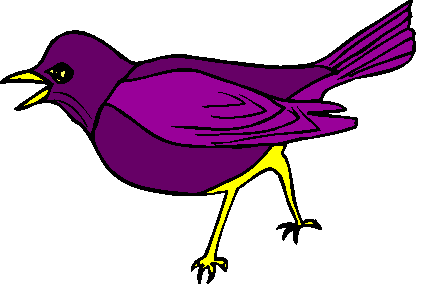Purple Martin Backyard Bird

About Purple Martin, Migratory Backyard Birds
A member of the swallow family, martins are popular birds with bird watchers and backyard enthusiasts. In particular, the Purple Martin is by far the most popular. Native to the Americas, these migratory birds are social creatures. They commonly live together in purple martin colonies. Each Fall they travel south thousands of miles to make their winter home in Central and South America. In the spring, they return to North America and can be found well into Canada.
Martins are cavity-dwelling birds. Originally, they made their homes in holes in trees. They prefer to live in groups, called “colonies”. With the arrival of English Sparrows to North America, Martins often rely on help from humans who provide Purple Martin Houses and habitat. Sparrows do not migrate and take over martin nests in the Fall. If allowed, they quickly move into a new martin house set up in the spring. Aggressive sparrows and starlings will also destroy martin eggs and newly hatched birds. Martin lovers erect martin houses and strive to evict any sparrows or starlings that try to move in.
Purple Martin Houses
To attract these birds, the very first thing you need is a purple martin house. Martins like to have other Martins as neighbors. They live in groups, called “colonies”. That’s why a martin house has multiple units, also called compartments or “apartments”. Select a multi-unit house on a long(tall) pole. It should be placed in the yard at least 30 feet away from houses, other objects, and trees. If you have a lot of open space, even larger distances are preferable. Ideally, place the house near water where there are lots of mosquitoes and other insects.
The house should have at least 6 to 8 units. The most popular houses hold 24 units for nesting pairs. That’s a community of 48 birds, plus babies! There should be a “porch” in front of each compartment. The house should be easy to clean out. As the “landlord”, you will want to play an active role in keeping the units clean and remove nests of sparrows or starlings, so there is a room to rent for the martins when they arrive. Even if one sparrow is in one of the units, martins will not move in.
As the “landlords”, we recommend you take down the Martin house for the winter, clean it up and make any necessary repairs. Then, put back up on the pole just before returning “scouts” come searching for a home in the spring.
Did you know? Gourds are also popular for cavity-dwelling martins. Birdhouse gourds and other gourds can be dried, hollowed out, and hung on poles. Like Martin houses, they will also attract sparrows and starlings.
Purple Martin Identification
Purple martins are the largest member of the swallow family. A mature bird measures up to 8 inches long. Bords do not get their final plumage until their 3rd year.
Adult males have blackish heads. The wings and stomachs appear purple. Yet they are not truly purple. Actually, light refraction causes them to appear navy blue to purple.
Females are a duller color with a white stomach.
The birds live an average of 5-7 years in the wild. However, it is not abnormal for a bird to live 7-8 years.
Purple Martin Diet
Purple Martins’ diet consists primarily of insects. They are renowned for their appetite for mosquitos. Many homeowners and bird lovers erect a Purple Martin house to attract this natural “mosquito control” bird. Studies show an adult Purple Martin can consume over 2,000 mosquitos a day. However, on a normal day, martins will consume a wide variety of insects, and only a fraction of that is mosquitos. Other insects on their diet include dragonflies, flies, beetles, moths, ants, grasshoppers, and even bees and wasps.
Don’t plan on seeing a martin at your bird feeder. They do not eat seeds. In rare situations of bad weather or when food is scarce, you may find them on the ground searching for worms, grubs, and other bugs.
How to Attract Purple Martins
When it comes to attracting Purple Martins, think shelter, food, and safety. Specifically, shelter is first on the list for a reason. Early are scouts are searching for your martin house or another suitable arrangement for the arriving colony.
You’ve probably already decided to buy and erect a Purple Martin House. Older birds will return year after year to the same house. You want to attract a bird that was born last year and is searching for your house. Strategically placed in an open area, your house will be spotted by returning “scouts”. They will return to the main flock and bring their “pals’. With a little luck, you will soon have several nesting pairs that take up residence and return year after year. It is not always easy to get your first tenets. But, once you do, they will return year after year.
Place a little nesting material in each compartment. Also, have nesting material lying around, in easy-to-spot places. Pine needles, straw, dried weeds, and tiny twigs work well.
Importantly, be vigilant in watching for sparrows and starlings attempting to “move in” before the arrival of the Purple Martins. If any do move in, clean out the house and continue to do so.
Purple Martin Enemies
Martins have a variety of enemies. If possible, takes steps to remove these predators:
Hawks and Owls- Natural predators
Raccoons
Snakes
Sparrows and Starlings- they move into the houses, and they destroy martin eggs.
More on Birds
Here is much more information on how to attract birds to your backyard:
Learn About Other Birds
Please support our site. Shop for:

- rmmatthews100@hotmail.com
- 585-721-6528
- Rochester, NY
©1999-2024 GardenersNet.Com, All Rights Reserved

